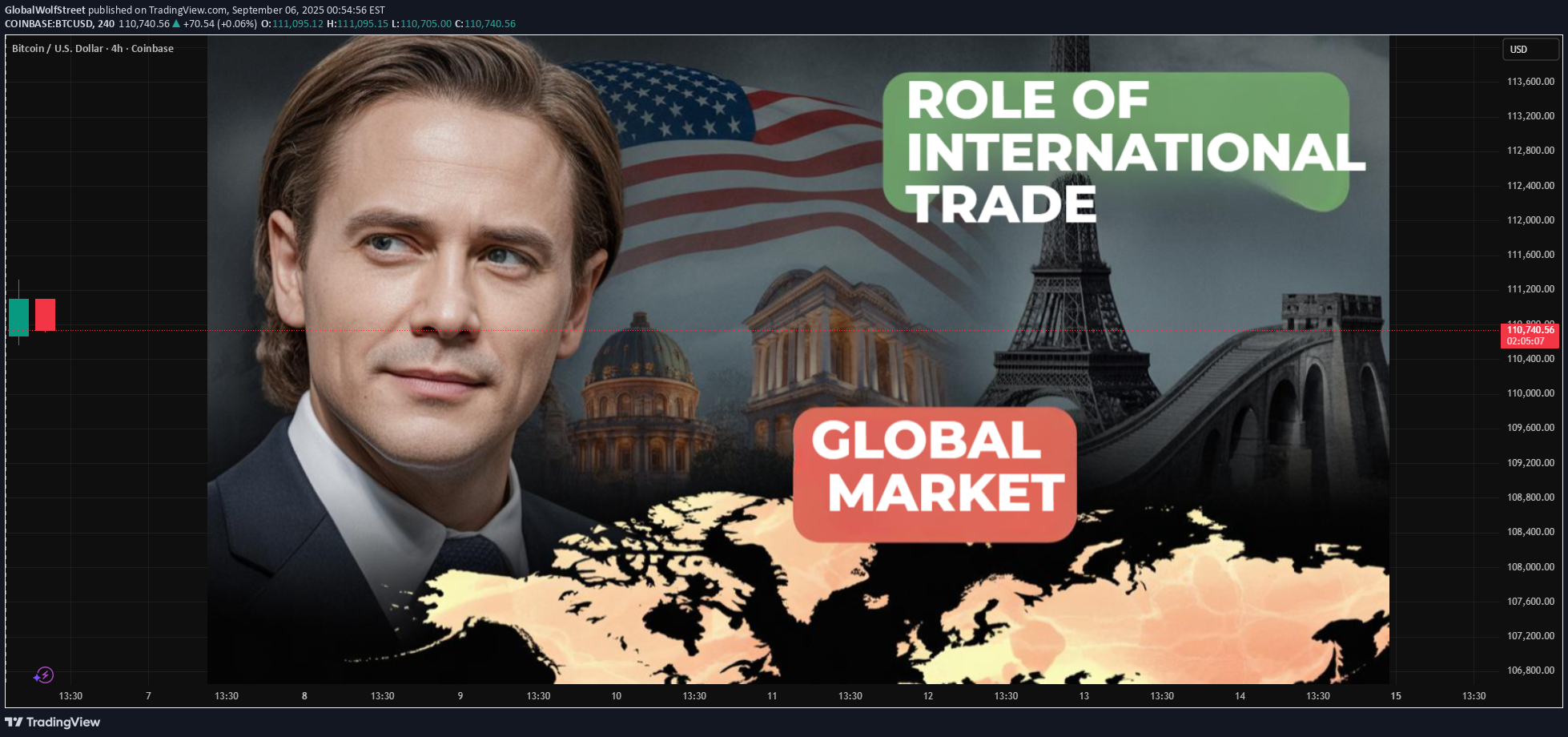Technical analysis by GlobalWolfStreet about Symbol BTC on 9/6/2025

1. Understanding International Trade International trade refers to the exchange of goods, services, capital, and ideas across national borders. Unlike domestic trade, which takes place within one country, international trade involves multiple currencies, laws, cultures, and business practices. Key Features: Cross-border transactions: Goods and services move from one country to another. Comparative advantage: Nations specialize in what they produce most efficiently. Use of currencies: Requires mechanisms for exchange rates and settlement. Government involvement: Tariffs, quotas, trade agreements, and regulations. Global institutions: WTO, IMF, World Bank, and regional trade blocs shape trade flows. Historical Perspective: Ancient trade routes like the Silk Road enabled cultural and material exchanges. Colonial trade in the 16th–19th centuries focused on raw material extraction and global shipping networks. Post–World War II saw the creation of institutions like the GATT (General Agreement on Tariffs and Trade), later evolving into the World Trade Organization (WTO), to facilitate rules-based trade. 21st-century trade involves digital commerce, global value chains (GVCs), and services-based exports such as IT, finance, and logistics. 2. The Economic Role of International Trade in Global Markets (a) Driver of Economic Growth International trade expands markets for producers, giving them access to consumers beyond national borders. For developing nations, it provides pathways to industrialization and modernization. For advanced economies, it ensures continued growth through exports and investment opportunities. Export-led growth: Economies like China, South Korea, and Singapore have grown exponentially by adopting export-oriented development strategies. Access to larger markets: Firms achieve economies of scale, producing more efficiently and lowering costs. Capital inflows: Foreign trade attracts foreign direct investment (FDI), creating jobs and infrastructure. (b) Resource Allocation and Efficiency Trade allows countries to specialize according to comparative advantage, leading to more efficient global resource use. For example: Middle Eastern countries specialize in oil exports. India exports IT services and pharmaceuticals. Germany exports automobiles and engineering products. This specialization boosts global productivity while lowering costs for consumers. (c) Contribution to GDP In most economies, international trade contributes significantly to GDP (Gross Domestic Product). For open economies like Singapore, trade (exports + imports) accounts for >300% of GDP. Even large economies like the US, China, and EU rely heavily on trade for growth. (d) Enhancing Consumer Choice Through trade, consumers gain access to a wider variety of goods and services—ranging from electronics and luxury cars to agricultural products and entertainment content. This improves living standards globally. (e) Job Creation and Employment Trade-intensive industries generate millions of jobs. Export manufacturing zones, service outsourcing, and logistics hubs provide direct employment while also stimulating indirect job creation in supporting industries. 3. International Trade and Market Integration (a) Global Value Chains (GVCs) Modern trade is characterized by the fragmentation of production. A single product, like an iPhone, is designed in the US, manufactured in China, with components sourced from Japan, Korea, and Germany. GVCs integrate multiple economies into a single supply network. (b) Financial Market Integration International trade requires financial flows, including payments, investments, and hedging. This leads to: Cross-border capital movement. Global financial interdependence. Development of international banking and currency markets. (c) Technology and Knowledge Transfer Trade facilitates the spread of technology and innovation. Multinational corporations bring modern techniques to host countries, enhancing productivity and competitiveness. (d) Formation of Trade Blocs Regional economic integration—like the European Union (EU), NAFTA/USMCA, ASEAN, and African Continental Free Trade Area (AfCFTA)—has reshaped global markets by reducing barriers and creating common markets. 4. Social and Political Role of International Trade (a) Promoting Peace and Cooperation Trade interdependence reduces the likelihood of conflicts. Nations that rely on each other for resources, markets, or investment have incentives to maintain peaceful relations. (b) Cultural Exchange Trade spreads not only products but also cultures, ideas, and lifestyles. For instance, Hollywood movies, K-pop, and yoga reached global audiences through trade-driven globalization. (c) Political Leverage Countries use trade as a tool of diplomacy or pressure. Sanctions, trade restrictions, and preferential trade agreements influence global politics. (d) Reducing Poverty Trade-led growth lifts millions out of poverty. For example, China’s integration into world trade since the 1980s has lifted over 800 million people above the poverty line. 5. Challenges of International Trade in Global Markets While trade drives growth, it also brings vulnerabilities. (a) Trade Imbalances Large deficits or surpluses can destabilize economies. For instance, the persistent US-China trade imbalance has fueled economic tensions. (b) Protectionism Countries often impose tariffs, quotas, or subsidies to protect domestic industries, which can trigger trade wars. Example: US-China tariff war (2018–2020). (c) Supply Chain Disruptions Events like the COVID-19 pandemic, the Russia-Ukraine war, and the Suez Canal blockage highlighted the fragility of global supply chains. (d) Inequality Trade benefits are unevenly distributed. While some sectors and regions thrive, others suffer job losses due to import competition or outsourcing. (e) Environmental Concerns Increased trade leads to higher carbon emissions from shipping and production, contributing to climate change. At the same time, global competition pressures industries to adopt environmentally unsustainable practices. 6. Role of International Institutions in Trade (a) World Trade Organization (WTO) Provides rules for global trade. Resolves disputes. Promotes free and fair competition. (b) International Monetary Fund (IMF) and World Bank Support balance-of-payments stability. Finance trade-related development projects. (c) Regional Organizations EU ensures a common market with free movement of goods, services, and people. ASEAN and USMCA promote regional cooperation. 7. Future of International Trade in Global Markets (a) Digital Trade and E-commerce Cross-border e-commerce platforms like Amazon, Alibaba, and Shopify are reshaping trade, making it easier for small businesses to reach global markets. (b) Services Trade Beyond goods, international trade in IT services, fintech, tourism, and online education is becoming a major growth driver. (c) Sustainable Trade Green trade policies are gaining prominence, focusing on renewable energy, low-carbon logistics, and sustainable sourcing. (d) Geopolitical Shifts The rise of China and India as global trade powerhouses. Trade realignment due to US-China rivalry. Increased focus on South-South trade among emerging markets. (e) Technological Innovations Blockchain, artificial intelligence, and digital currencies may revolutionize trade logistics, payments, and transparency. Conclusion International trade is the backbone of global markets. It enables countries to grow beyond their domestic limitations, enhances efficiency through specialization, and integrates the world into a complex but interdependent economic system. While trade has its challenges—ranging from inequality and environmental concerns to geopolitical tensions—it remains an irreplaceable driver of globalization and prosperity. In the coming decades, the role of international trade will evolve further, shaped by technology, sustainability, and geopolitics. Countries that adapt effectively, balancing openness with resilience, will thrive in an interconnected global marketplace.
